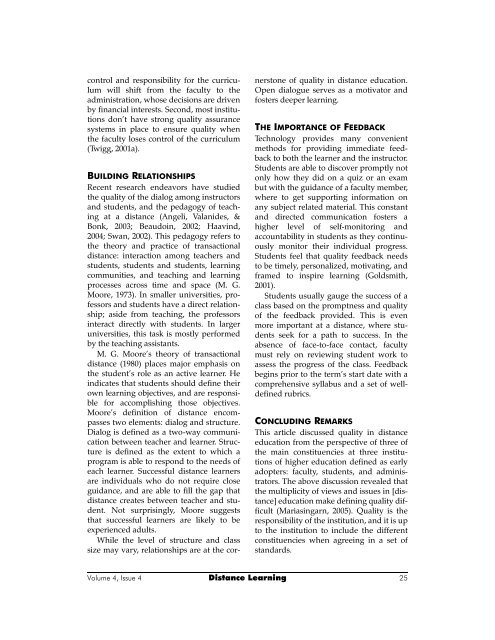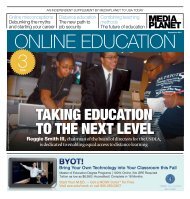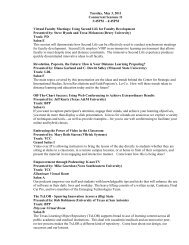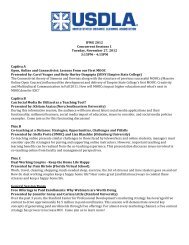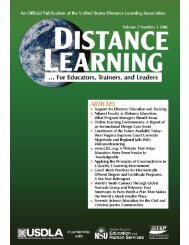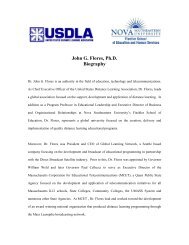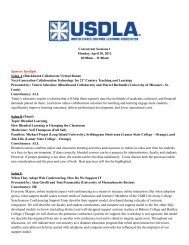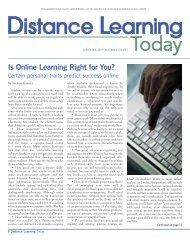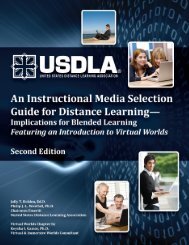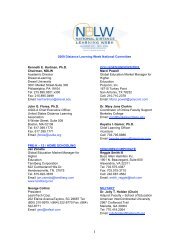United States Distance Learning Association
United States Distance Learning Association
United States Distance Learning Association
- No tags were found...
You also want an ePaper? Increase the reach of your titles
YUMPU automatically turns print PDFs into web optimized ePapers that Google loves.
control and responsibility for the curriculum<br />
will shift from the faculty to the<br />
administration, whose decisions are driven<br />
by financial interests. Second, most institutions<br />
don’t have strong quality assurance<br />
systems in place to ensure quality when<br />
the faculty loses control of the curriculum<br />
(Twigg, 2001a).<br />
BUILDING RELATIONSHIPS<br />
Recent research endeavors have studied<br />
the quality of the dialog among instructors<br />
and students, and the pedagogy of teaching<br />
at a distance (Angeli, Valanides, &<br />
Bonk, 2003; Beaudoin, 2002; Haavind,<br />
2004; Swan, 2002). This pedagogy refers to<br />
the theory and practice of transactional<br />
distance: interaction among teachers and<br />
students, students and students, learning<br />
communities, and teaching and learning<br />
processes across time and space (M. G.<br />
Moore, 1973). In smaller universities, professors<br />
and students have a direct relationship;<br />
aside from teaching, the professors<br />
interact directly with students. In larger<br />
universities, this task is mostly performed<br />
by the teaching assistants.<br />
M. G. Moore’s theory of transactional<br />
distance (1980) places major emphasis on<br />
the student’s role as an active learner. He<br />
indicates that students should define their<br />
own learning objectives, and are responsible<br />
for accomplishing those objectives.<br />
Moore’s definition of distance encompasses<br />
two elements: dialog and structure.<br />
Dialog is defined as a two-way communication<br />
between teacher and learner. Structure<br />
is defined as the extent to which a<br />
program is able to respond to the needs of<br />
each learner. Successful distance learners<br />
are individuals who do not require close<br />
guidance, and are able to fill the gap that<br />
distance creates between teacher and student.<br />
Not surprisingly, Moore suggests<br />
that successful learners are likely to be<br />
experienced adults.<br />
While the level of structure and class<br />
size may vary, relationships are at the cornerstone<br />
of quality in distance education.<br />
Open dialogue serves as a motivator and<br />
fosters deeper learning.<br />
THE IMPORTANCE OF FEEDBACK<br />
Technology provides many convenient<br />
methods for providing immediate feedback<br />
to both the learner and the instructor.<br />
Students are able to discover promptly not<br />
only how they did on a quiz or an exam<br />
but with the guidance of a faculty member,<br />
where to get supporting information on<br />
any subject related material. This constant<br />
and directed communication fosters a<br />
higher level of self-monitoring and<br />
accountability in students as they continuously<br />
monitor their individual progress.<br />
Students feel that quality feedback needs<br />
to be timely, personalized, motivating, and<br />
framed to inspire learning (Goldsmith,<br />
2001).<br />
Students usually gauge the success of a<br />
class based on the promptness and quality<br />
of the feedback provided. This is even<br />
more important at a distance, where students<br />
seek for a path to success. In the<br />
absence of face-to-face contact, faculty<br />
must rely on reviewing student work to<br />
assess the progress of the class. Feedback<br />
begins prior to the term’s start date with a<br />
comprehensive syllabus and a set of welldefined<br />
rubrics.<br />
CONCLUDING REMARKS<br />
This article discussed quality in distance<br />
education from the perspective of three of<br />
the main constituencies at three institutions<br />
of higher education defined as early<br />
adopters: faculty, students, and administrators.<br />
The above discussion revealed that<br />
the multiplicity of views and issues in [distance]<br />
education make defining quality difficult<br />
(Mariasingarn, 2005). Quality is the<br />
responsibility of the institution, and it is up<br />
to the institution to include the different<br />
constituencies when agreeing in a set of<br />
standards.<br />
Volume 4, Issue 4 <strong>Distance</strong> <strong>Learning</strong> 25


